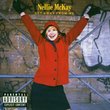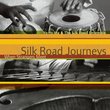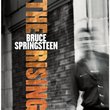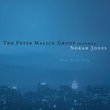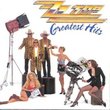| All Artists: Leif Ove Andsnes, Wolfgang Amadeus Mozart, Norwegian Chamber Orchestra Title: Mozart: Piano Concertos #9 & 18 - Leif Ove Andsnes Members Wishing: 0 Total Copies: 0 Label: EMI Classics Release Date: 11/2/2004 Genre: Classical Styles: Forms & Genres, Concertos, Historical Periods, Classical (c.1770-1830), Instruments, Keyboard, Symphonies Number of Discs: 1 SwapaCD Credits: 1 UPC: 724355780324 |
Search - Leif Ove Andsnes, Wolfgang Amadeus Mozart, Norwegian Chamber Orchestra :: Mozart: Piano Concertos #9 & 18 - Leif Ove Andsnes
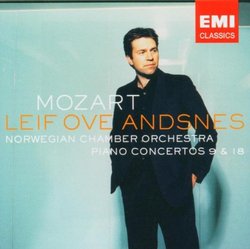 | Leif Ove Andsnes, Wolfgang Amadeus Mozart, Norwegian Chamber Orchestra Mozart: Piano Concertos #9 & 18 - Leif Ove Andsnes Genre: Classical
This record is a total delight: two irresistible Mozart concertos, one famous, one unfamiliar, played with the technical, musical and stylistic perfection that performers never cease to strive for but very rarely achieve. ... more » |
Larger Image |
CD DetailsSynopsis
Amazon.com This record is a total delight: two irresistible Mozart concertos, one famous, one unfamiliar, played with the technical, musical and stylistic perfection that performers never cease to strive for but very rarely achieve. No. 9, written in 1777, was the first of Mozart's large-scale, truly "great" concertos. Innovative in form, it opens not with the usual orchestral exposition, but a brief interchange between soloist and orchestra that sets the stage for its conversational character. In the C minor slow movement, the piano sings a heart-breaking lament of an aria while the orchestra comments with often wrenchingly dissonant sighs. The sprightly, exuberant Finale harbors another surprise. Its middle section is a Minuet of beguiling beauty and wistful grace. No. 18, written in 1784, is basically conventional, but also full of surprises, notably in its daring modulations to distant tonalities. The slow movement in G minor is another mournful operatic aria, while the Finale is a set of increasingly ornate variations. Andsnes' playing is quite extraordinary. He follows Mozart through all his swiftly changing moods and emotions, bringing out the music's stately nobility, gracious courtliness, ironic humor, drama and tragedy without a trace of artificiality or exaggeration. He uses Mozart's own wonderfully inventive, sparkling cadenzas, which adds to the feeling of authenticity. The piano tone is light, crisp and clear, but so variable in touch, articulation and nuance that it never sounds dry. The transitions and changes of tempo and character are poised and natural, the rhythms buoyant and supple. The phrasing is impeccable and has the spontaneous flow of human speech. The orchestra plays with sparing vibrato but lots of color and expression; its tone blends with the piano's admirably, cushioning and vitalizing the solo part. One can easily imagine Mozart sitting at the keyboard in close rapport with the musicians, basking in the audiences' enjoyment and smiling with pure pleasure. --Edith Eisler Similarly Requested CDs
|
CD ReviewsAs good as it gets Richard Steiger | Murray, KY USA | 03/06/2005 (5 out of 5 stars) "I don't know what to praise here first, so I'll begin with the music. #9 is, of course, one of Mozart's best-known concertos, but #18 is rarely played in the concert hall. I cannot understand why, as it is every bit as great as the concertos that surround it, with an eloquent slow movement and wonderfully rollicking finale. I'm not familiar with the Norwegian Chamber Orchestra, but they are clearly one of the worl's finest ensembles, playing with extraordinary precision and zest. The recorded sound is exemplary, the balance between piano and orchestra perfect. As for Andsnes, his playing is wonderfully alert at every moment, full of brio in the lively moments and lyricism where called for (particularly in the slow movement of 18, played, to very good effect, somewhat faster than usual. I compared this recording of 18 to Perahia's with the ECO and found that Perahia played splendidly as ever, but he's much too closely recorded and the English Chamber Orchestra sounds diffuse and, frankly, clumsy. In every way, this release strikes me as exemplary. Anyone who purchases this disc is guaranteed an hour of pure pleasure." Talented Andsnes Tackles Mozart With Precision and Style Ed Uyeshima | San Francisco, CA USA | 01/15/2005 (4 out of 5 stars) "Having just enjoyed Leif Ove Andsnes' dramatically effective playing on his recording of Schubert's "Winterreise" with tenor Ian Bostridge, I wanted to see if I could enjoy his work without the accompaniment of a voice. With this recording, I can more fully appreciate the virtuoso trills and runs and overall warmth he brings to these two Mozart concertos. The two pieces make an interesting contrast: the Ninth seems darker with an almost epic feel, while Concerto #18 is far livelier and more expressive. In particular, the middle Andantino section of the Ninth has a haunting quality, almost like a dirge, where Andsnes plays with such mournful feeling that he replaces what would have surely been a moaning voice. However, both concertos still contain a generous number of Mozart's trademark credenzas, which provide a familiar sparkle to the overall performance. The brief CD booklet lends some interesting insight into the origins of the pieces, as Mozart apparently wrote each for two different female musicians to play. The emotional, almost airy freedom and harmonic colorations expressed in #18 seems to attest to this apocryphal fact, as a blind and prodigiously pianist named Maria Theresia Paradis is said to have introduced it in Paris in 1784. The superb Norwegian Chamber Orchestra creates a strong and fulsome sound on both concertos, melding horns, woodwinds and strings to great effect. Andsnes responds by performing with great precision and stays true to the composer's familiar musical style with a genuine period flavor. I doubt if purists would be disappointed. The recording also captures the ideal tonal balance between Andsnes and the other musicians so that neither is overwhelmed by the other, a true ensemble. In fact, the aural qualities are so perfect that there are times when I was hoping for a little more adventurousness in approach, something that would challenge our perceptions of Mozart's music. To some degree, what the disc lacks is a truly individual mark that would make it transcendent, but give Andsnes some time to hone his obviously tremendous talent into something truly memorable. As it stands though, it's a very well planned and impeccably performed recording and not to slight it, but it makes the perfect background music for a Sunday brunch." Leif Ove Andsnes: A Musician's AND an Audience's Musician! Grady Harp | Los Angeles, CA United States | 08/08/2005 (5 out of 5 stars) "Though Leif Ove Andsnes has been on concert stages for some time now, he is finally reaching that estimable stature of one the now and future greats. This eloquent CD of two superb Mozart concerti (Nos. 9 and 18) will certainly contribute to his place in the ranks of fine pianists. Not only does he play with a refined sense of architecture and with utmost clarity, he is not afraid to let the singing, aria-like movements show his heart.
One other factor that makes this recital so worth owning is Andsnes' conducting the Norwegian Chamber Orchestra from the keyboard. The result is a marriage of thought and performance that makes these readings among the best available. The orchestra is utterly responsive to his interpretation and though the group is not a 'period orchestra', the sound Andsnes coaxes from them must be very close to the sound Mozart heard as he conducted them in 1777 and 1784 - less vibrato, playing a 'straight line' sound that simulates period instruments without sacrificing the warmth of modern orchestral timber. Highly recommended. Grady Harp, August 05" |

 Track Listings (6) - Disc #1
Track Listings (6) - Disc #1